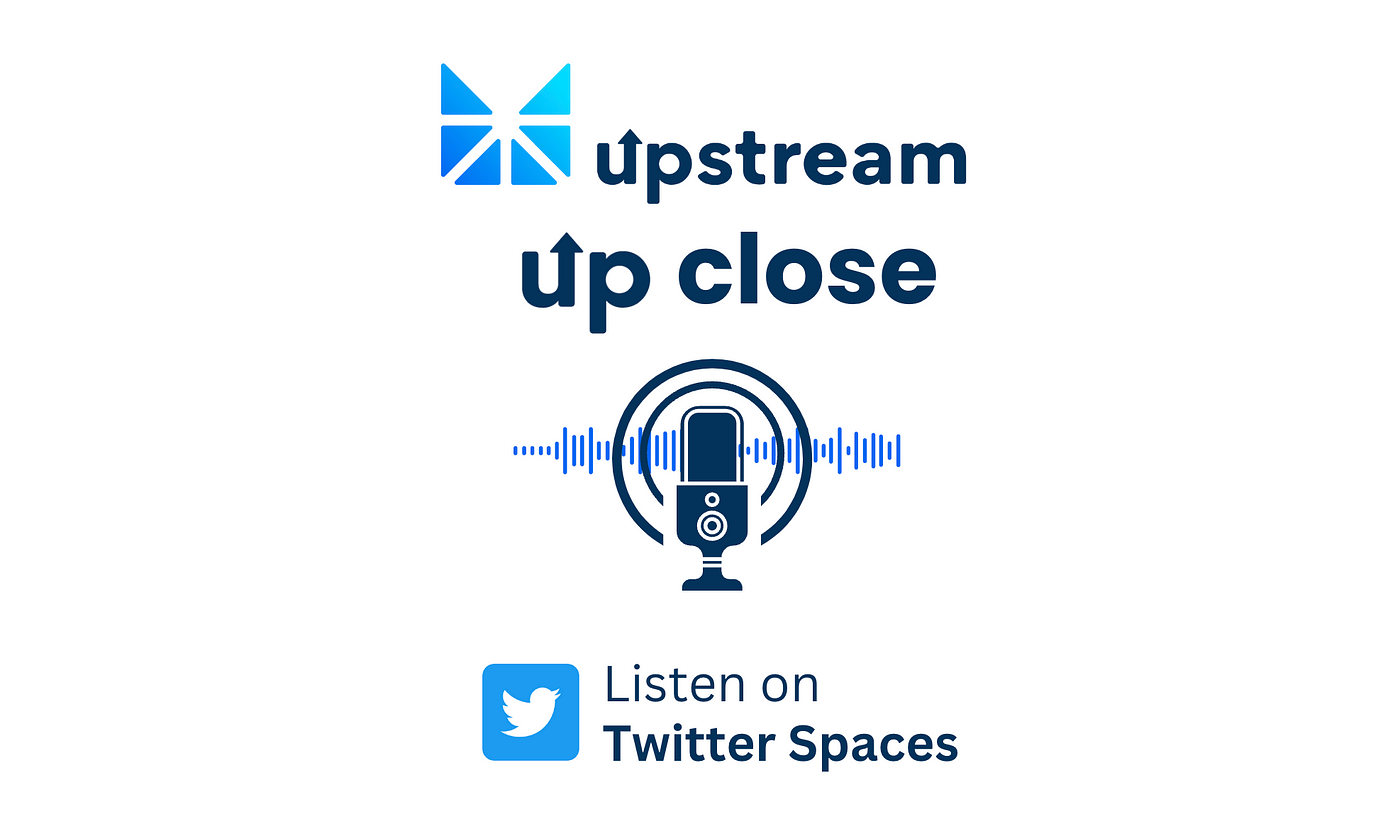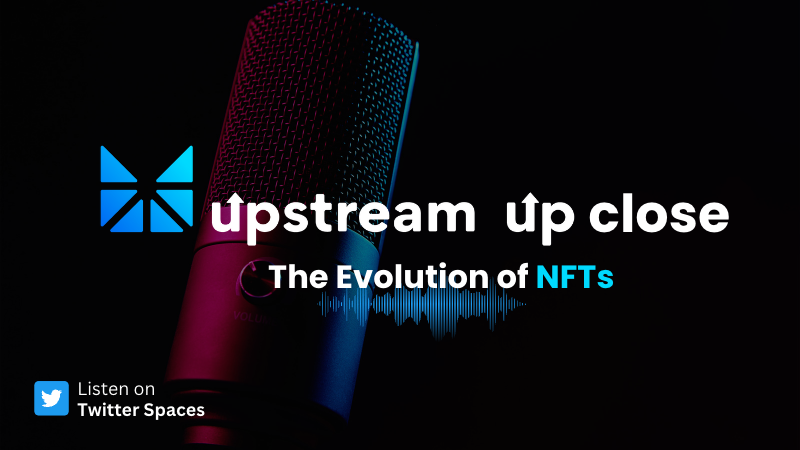
By Anastasia Samaras
This week, the Upstream team published the second episode of their new Twitter Spaces series, ‘Upstream Up Close’, featuring 10–15 minute conversations about NFTs, blockchain, and trading on Upstream. This second episode focused on the Evolution of NFTs which explored how NFTs started, where they are now, and where we will see them going in the future!
Listen HERE to Upstream Up Close: The Evolution of NFTs
Leading the conversation was Vanessa, Upstream’s Head of Marketing, Amanda, Client Success Coordinator, Anastasia, and Fernanda, Digital Marketing Specialist, who shared their understanding of the NFT timeline and how NFTs have shifted.
Especially in the past few years, NFTs have become a hot topic of discussion, with news of multimillion-dollar sales and high-profile artists and celebrities embracing this new technology. But where did NFTs come from and how have they evolved into the digital assets we know today?
NFTs have actually been around for over a decade, but it’s only recently that they’ve gained widespread attention and appreciation.
Initially, NFTs emerged as speculative investment opportunities, but with the adjacent Crypto Winter in 2022 and rising regulatory pressures, the focus has shifted to additional use cases.
It’s these NFT use cases surrounding digital collectibles, digital rewards, and interactive experiences made immutable by blockchain technology that we believe will have a meaningful, and long-lasting impact on how we think about ownership in the digital age.
Here are some key points from our discussion:
- In 2012, colored coins were introduced as a way of representing digital assets on the Bitcoin blockchain. The idea was to allow users to “color” a fraction of a Bitcoin and represent it as a unique asset on the blockchain.
- In 2014, Counterparty’s decentralized platform was built on top of the Bitcoin blockchain. It was one of the first platforms to offer NFT functionality, allowing users to create and trade digital assets using a custom token standard.
- The initial expansion fell short because of limited smart contract support to handle ownership transfers on Bitcoin. The rise of the Ethereum blockchain solved this with easier onboarding, greater smart contract abilities, and lower barriers of entry for NFTs. This is when we started to see the birth of PFP NFTs (profile-picture NFTs).
- Some notable examples of the success of NFTs include the Bored Ape NFT series, which saw all 10,000 of its computer-generated cartoon apes sell out within hours of their release.
- Another significant moment for the NFT market was when artist Beeple sold an NFT of his work for a staggering $69 million at Christie’s, underscoring the increasing demand for digital art and the potential for NFTs to revolutionize the art world.
- Celebrity hype helped to draw new consumers to crypto outside of the original bubble. There was proof of this as the popularity of Bored Ape Yacht Club, CryptoPunks and other NFT collectibles drove the NFT market value to a peak of $19.1 billion in February 2022¹.
- The NFT market as we knew it was greatly impacted by the adjacent Crypto Winter in 2022. Crypto Winter is a term used for a period of market cooling thought to have first been used in 2018 when the price of Bitcoin dropped by more than 50% from its all-time high. This latest crypto winter period included cryptocurrency prices dropping, FTX’s collapse, and the increase in regulatory pressures.
- While the NFT market has certainly experienced its share of ups and downs, including the impact of the recent Crypto Winter, the adaptability and expanding utility of NFTs has helped to ensure their survival.
- These digital assets have proven to be a powerful tool for fan engagement, digital rewards, and utility across various industries, including sports, universities, and more.
- The concept of scarcity, which is a foundation for NFTs, continues to attract brands, creators, and audiences alike, highlighting the potential for these unique digital assets to have a lasting impact on the world of digital art and collectibles.
- Upstream is working with various clients on NFT Types that are utility focused. This is a new way to create more intimate Web3 experiences between brands/celebrities and their consumers/fans. A majority of our NFTs campaigns include something tangible, whether that’s an item or experience. By adding that tangibility to the NFTs, it creates a value that translates to the everyday person who may not understand the digital worth of NFTs right now.
Word of the segment: PFP
One of the most significant innovations in the NFT space has been the emergence of PFP NFTs. These unique digital assets are algorithmically generated through computer code and offer users ownership of a one-of-a-kind character or avatar for use as their profile picture. Unlike traditional NFTs, each person who purchases a PFP NFT receives a unique token for a unique variation of the image, making them especially appealing to fans of digital art and collectibles.

If you missed the episode or you’re interested in learning more about the evolution of NFTs, listen anytime, anywhere by clicking the link above.
Upstream is a MERJ Exchange market. We’re the first regulated securities and NFT market powered by blockchain technology. We built our NFT market for the 99% of the world that may not know what NFTs, gas fees, or Metamask are. We simplified the process to create, purchase, and trade NFTs with a few clicks all from our user-friendly trading app.
Stay tuned for our next episode!
Source
1 | CoinTelegraph |
Disclaimers
This communication shall not constitute an offer to sell securities or the solicitation of an offer to buy securities in any jurisdiction where such offer or solicitation is not permitted.
NFTs have no royalties, equity ownership, or dividends. NFTs are for utility, collection, redemption, or display purposes only. Anyone may buy and sell NFTs on Upstream.
* U.S. or Canadian-based citizen or permanent are not currently able to deposit, buy, or sell securities on Upstream at this time without being introduced by a licensed broker dealer. Note that U.S. or Canadian-based investors include those U.S. or Canadian citizens who may be domiciled overseas.
Upstream is a MERJ Exchange market. MERJ Exchange is a licensed Securities Exchange, an affiliate of the World Federation of Exchanges, a National Numbering Agency and member of ANNA. MERJ supports global issuers of traditional and digital securities through the entire asset life cycle from issuance to trading, clearing, settlement, and registry. It operates a fair and transparent marketplace in line with international best practices and principles of operations of financial markets. Upstream does not endorse or recommend any public or private securities bought or sold on its app. Upstream does not offer investment advice or recommendations of any kind. All services offered by Upstream are intended for self-directed clients who make their own investment decisions without aid or assistance from Upstream. All customers are subject to the rules and regulations of their jurisdiction. By accessing the site or app, you agreed to be bound by its terms of use and privacy policy. Company and security listings on Upstream are only suitable for investors who are familiar with and willing to accept the high risk associated with speculative investments, often in early and development stage companies. There can be no assurance the valuation of any particular company’s securities is accurate or in agreement with the market or industry comparative valuations. Investors must be able to afford market volatility and afford the loss of their investment. Companies listed on Upstream are subject to significant ongoing corporate obligations including, but not limited to disclosure, filings, and notification requirements, as well as compliance with applicable quantitative and qualitative listing standards.
Forward-Looking Statements
This communication contains “forward-looking statements.” Such statements may be preceded by the words “intends,” “may,” “will,” “plans,” “expects,” “anticipates,” “projects,” “predicts,” “estimates,” “aims,” “believes,” “hopes,” “potential,” or similar words. Forward-looking statements are not guarantees of future performance, are based on certain assumptions, and are subject to various known and unknown risks and uncertainties, many of which are beyond the Company’s control, and cannot be predicted or quantified, and, consequently, actual results may differ materially from those expressed or implied by such forward-looking statements. Such risks and uncertainties include, without limitation, risks and uncertainties associated with (i) difficulties in obtaining financing on commercially reasonable terms; (ii) changes in the size and nature of our competition; (iii) loss of one or more key executives or brand ambassadors; and (iv) changes in legal or regulatory requirements in the markets in which we operate. The Company assumes no obligation to publicly update or revise its forward-looking statements as a result of new information, future events or otherwise.

